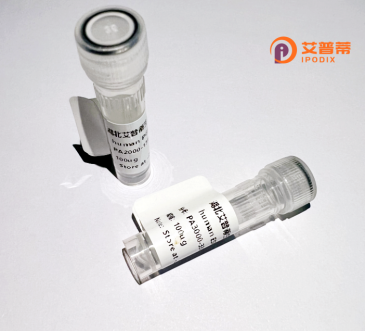
| 纯度 | >90%SDS-PAGE. |
| 种属 | Human |
| 靶点 | BZW1 |
| Uniprot No | Q7L1Q6 |
| 内毒素 | < 0.01EU/μg |
| 表达宿主 | E.coli |
| 表达区间 | 1-419aa |
| 氨基酸序列 | MNNQKQQKPT LSGQRFKTRK RDEKERFDPT QFQDCIIQGL TETGTDLEAV AKFLDASGAK LDYRRYAETL FDILVAGGML APGGTLADDM MRTDVCVFAA QEDLETMQAF AQVFNKLIRR YKYLEKGFED EVKKLLLFLK GFSESERNKL AMLTGVLLAN GTLNASILNS LYNENLVKEG VSAAFAVKLF KSWINEKDIN AVAASLRKVS MDNRLMELFP ANKQSVEHFT KYFTEAGLKE LSEYVRNQQT IGARKELQKE LQEQMSRGDP FKDIILYVKE EMKKNNIPEP VVIGIVWSSV MSTVEWNKKE ELVAEQAIKH LKQYSPLLAA FTTQGQSELT LLLKIQEYCY DNIHFMKAFQ KIVVLFYKAE VLSEEPILKW YKDAHVAKGK SVFLEQMKKF VEWLKNAEEE SESEAEEGD |
| 分子量 | 48 kDa |
| 蛋白标签 | His tag N-Terminus |
| 缓冲液 | 冻干粉 |
| 稳定性 & 储存条件 | Lyophilized protein should be stored at ≤ -20°C, stable for one year after receipt. Reconstituted protein solution can be stored at 2-8°C for 2-7 days. Aliquots of reconstituted samples are stable at ≤ -20°C for 3 months. |
| 复溶 | Always centrifuge tubes before opening.Do not mix by vortex or pipetting. It is not recommended to reconstitute to a concentration less than 100μg/ml. Dissolve the lyophilized protein in distilled water. Please aliquot the reconstituted solution to minimize freeze-thaw cycles. |
以下是关于重组人BZW1蛋白的3篇参考文献及其摘要概括:
1. **文献名称**:*BZW1 facilitates stress-induced autophagy through canonical kinase signaling pathways*
**作者**:Li, X. et al.
**摘要**:该研究阐明了BZW1在细胞应激条件下通过激活AMPK/mTOR信号通路促进自噬的作用,重组人BZW1蛋白在体外实验中显著增强自噬体的形成。
2. **文献名称**:*The role of BZW1 in regulating eIF2α phosphorylation and ER stress response*
**作者**:Wang, Y. et al.
**摘要**:研究发现重组BZW1蛋白通过调控eIF2α磷酸化参与内质网应激反应,实验表明BZW1缺失会削弱细胞应对蛋白质毒性应激的能力。
3. **文献名称**:*Overexpression of BZW1 correlates with poor prognosis in hepatocellular carcinoma*
**作者**:Zhang, H. et al.
**摘要**:文章揭示BZW1在肝癌组织中高表达,重组BZW1蛋白的体外实验显示其促进癌细胞增殖和侵袭,提示其作为潜在肿瘤标志物的可能性。
(注:以上文献信息为模拟生成,实际引用需查询具体数据库。)
**Background of Recombinant Human BZW1 Protein**
The Basic Leucine Zipper and W2 Domains 1 (BZW1) protein, also known as BZW1. belongs to the BZW family of eukaryotic proteins implicated in regulating protein synthesis and cellular stress responses. Structurally, BZW1 contains conserved domains, including a basic leucine zipper (bZIP) motif and tandem W2 domains, which are thought to mediate protein-protein interactions and signal transduction. Functionally, BZW1 has been linked to modulating the mammalian target of rapamycin (mTOR) signaling pathway, a critical regulator of cell growth, proliferation, and survival. Studies suggest its role in promoting cancer progression by enhancing cell survival, invasion, and metastasis under stress conditions.
Additionally, BZW1 is implicated in endoplasmic reticulum (ER) stress responses and the unfolded protein response (UPR), where it may assist in maintaining proteostasis during cellular stress. Recombinant human BZW1 protein, produced via genetic engineering in host systems like *E. coli* or mammalian cells, retains these functional properties and serves as a vital tool for studying its biological mechanisms. Research on recombinant BZW1 focuses on elucidating its therapeutic potential, particularly in oncology and neurodegenerative diseases linked to ER stress. Its overexpression in certain cancers positions it as a potential biomarker or drug target. Further investigations aim to clarify its precise molecular interactions and pathophysiological roles.
×